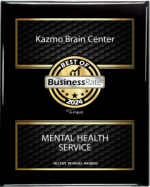Everyone experiences anxiety at some point in their life. For instance, you might feel worried and anxious about taking an exam, undergoing a medical test, or attending a job interview. In such situations, feeling nervous is perfectly normal.
However, some individuals struggle to manage their worries. Their anxiety is more persistent and can frequently interfere with their daily lives.
Generalized Anxiety Disorder (GAD) is a common and usually serious mental health condition that affects many people around the world.
It involves constant and excessive worry about different parts of life, which can make daily activities difficult and lower quality of life.
1. Symptoms of Generalized Anxiety Disorder
People with GAD experience persistent and excessive worry that is difficult to control. This nervousness often revolves around everyday situations such as health, work, social interactions, and routine life circumstances. Common symptoms include excessive worrying involves stressing more than usual about various things, often without a clear reason.
It includes feeling agitated and on edge, having difficulty relaxing, frequently feeling tired even after adequate rest, struggling to concentrate or experiencing a blank mind, and becoming easily annoyed or angered.
These symptoms must be present for most days over at least six months to meet the diagnostic criteria for GAD.
2. Causes and Risk Factors
The exact cause of GAD is not fully understood, but it likely results from a combination of genetic, environmental, psychological, and developmental factors.
Some known risk factors include:
- Genetics: A family history of anxiety disorders can increase the likelihood of developing GAD.
- Brain Chemistry: Imbalances in certain neurotransmitters, such as serotonin and dopamine, are associated with anxiety disorders.
- Life Experiences: Trauma, stress, and significant life changes can trigger or exacerbate anxiety.
3. Diagnosis of GAD
The Diagnostic and Statistical Manual of Mental Disorders (DSM-5) outlines specific criteria for diagnosing GAD, including the presence of excessive worry and anxiety more days than not for at least six months, along with at least three of the associated symptoms (restlessness, fatigue, difficulty concentrating, irritability, muscle tension, and sleep disturbances).
4. Treatment Options
Effective treatment for GAD often involves a combination of therapy, medication, and lifestyle changes:
- Psychotherapy: Cognitive Behavioral Therapy (CBT) is the most widely used therapeutic approach for GAD. CBT helps individuals identify and challenge negative thought patterns and develop coping strategies.
- Medication: Antidepressants (such as SSRIs and SNRIs) and anti-anxiety medications (such as benzodiazepines) can help manage symptoms. Medications should be prescribed and monitored by a healthcare professional.
- Lifestyle Changes: Regular physical activity, a healthy diet, adequate sleep, and stress management techniques (such as mindfulness and relaxation exercises) can support overall well-being and reduce anxiety symptoms.
5. Coping Strategies
In addition to professional treatment, individuals with GAD can benefit from self-help strategies, including:
- Mindfulness and Meditation: Practicing mindfulness and meditation can help reduce anxiety and improve emotional regulation.
- Time Management: Organizing tasks and setting realistic goals can reduce feelings of being overwhelmed.
- Social Support: Building a strong support network of friends, family, and support groups can provide emotional comfort and practical assistance.
Reach out for help at Kazmo Brain Center
Generalized Anxiety Disorder is a common and challenging condition, but with the right treatment and support, individuals can manage their symptoms and lead fulfilling lives.
Understanding the case would be of major help in order to overcome GAD.
Getting the help you need is key, and at our center, you will find the required support. Contact us at: [email protected] to book your appointment.
Read more: What is High-Functioning Depression







